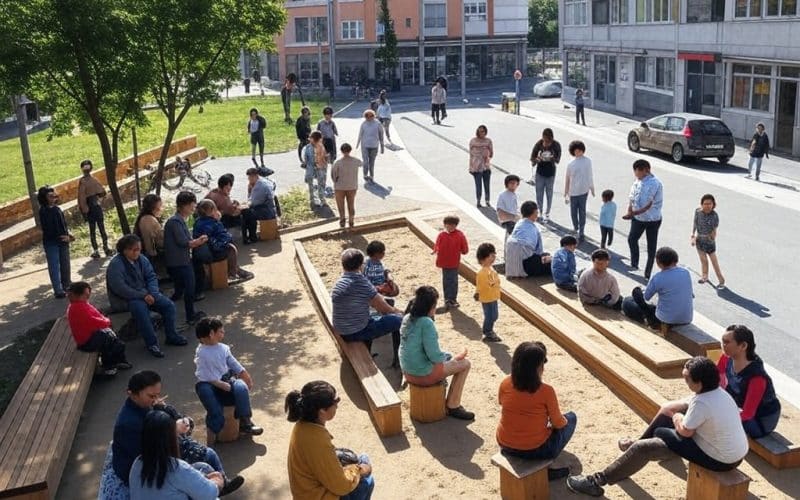
Cities keep growing fast. This explosive growth creates traffic, pollution, and limited access to necessities. Urban planners seek ways to make city life more sustainable and equitable. One powerful strategy is the 15-minute city. It aims to place work, schools, shopping, and leisure all within a short walk or bike ride. This approach reduces car dependence, boosts quality of life, and nurtures a healthier environment.
French-Colombian urban planner Carlos Moreno popularized this idea. It now shapes policies in global cities such as Paris, Melbourne, and Portland. What does this model entail? How does it function? What rewards and hurdles does it present? Explore this urban transformation below.
Understanding the Core Principles of the 15-Minute City
The 15-minute city rests on foundational principles that shape sustainable and accessible urban living.
Proximity: Everything Within Reach. You reach essential services – workplaces, schools, groceries, healthcare, entertainment, and recreation – within a 15-minute stroll or bike ride. This short distance removes lengthy commutes and fosters a local-focused lifestyle.
Diversity: A Blend of Functions and Services. Mixed-use zoning brings housing, businesses, and industrial areas close together. Different activities – living, working, shopping, and socializing – unfold side by side. This mix ignites local economies and strengthens neighborhood ties.
Density: Compact and Efficient Design. High-density development keeps essential services within easy reach. Compact layouts reduce wasted travel time. Mixed-use buildings let you live near jobs, shops, and social venues.
Mobility: Prioritizing Pedestrians and Cyclists. In a true 15-minute city, walking and biking come first. Thoughtful design features wide sidewalks, protected bike lanes, and pedestrian-only streets, making car-free travel quick and safe.
Sustainability: Cleaner and Greener Cities. Lower car usage cuts emissions and improves air quality. Integrating renewable energy, green spaces, and eco-friendly architecture helps create healthier communities and resilient urban environments.
Key Features of the 15-Minute City
Certain features bring the 15-minute city to life. These elements complement one another to form a functional, sustainable urban space.
- Walkability and Cycling Infrastructure. Traditional car-focused cities often shortchange walkers and cyclists. A 15-minute city fixes that by prioritizing well-maintained sidewalks, crosswalks, and dedicated bike paths. Traffic-calming measures and pedestrian zones encourage walking. Safe bike lanes, secure parking, and bike-share programs let you pedal wherever you need to go.
Example: Copenhagen, Denmark, leads with advanced cycling networks. Over 62% of Copenhageners rely on bikes as their main transport mode, which cuts congestion and cleans the air.
- Mixed-Use Neighborhoods. Zoning that separates housing, commerce, and industry forces long trips. A 15-minute city eliminates that separation. Homes, shops, offices, and public spaces coexist. This variety attracts foot traffic, bolsters local businesses, and keeps commutes short.
Example: Paris, France, under Mayor Anne Hidalgo, champions the 15-minute city by reshaping streets. Many once car-dominated roads now feature pedestrian areas and co-working spaces, creating lively local hubs.
- Access to Essential Services. The 15-minute city ensures you can quickly reach key needs:
- Healthcare (clinics, pharmacies)
- Education (schools, libraries)
- Retail (markets, grocery stores)
- Financial services (banks, ATMs)
- Leisure (museums, restaurants)
Localizing these services promotes equity and convenience.
Example: Portland, Oregon (USA), enforces policies that bolster mixed-use projects. Residents enjoy easier access to vital amenities in their own neighborhoods.
- Green Spaces and Public Areas. Parks, gardens, and recreational spots are crucial to urban wellness. The 15-minute city threads greenery throughout every district, so you enjoy nature without a long commute. Greenery also improves air quality, supports mental health, and helps neighbors forge connections.
Example: Melbourne, Australia, weaves green corridors into city planning, boosting biodiversity and ensuring convenient access to parks.
- Local Employment and Co-Working Spaces. Modern cities often push residential zones far from work districts, causing stressful commutes. The 15-minute model encourages businesses to open offices nearby. Remote work and co-working centers also let you work closer to home. This approach reduces congestion, saves time, and strengthens neighborhood economics.
Example: Milan, Italy, invests in local co-working venues. This alleviates downtown crowding and enables more balanced work-life integration.
Challenges and Criticism of The 15-Minute City
Despite its advantages, the 15-minute city faces obstacles:
- Existing Car-Centric Infrastructure. Many cities rely heavily on roads, making transitions difficult.
- Affordability and Gentrification. Property values can rise, forcing out lower-income groups.
- Zoning and Policy Limitations. Outdated regulations may block mixed-use developments.
- Cultural Resistance. Some residents hesitate to abandon car-oriented lifestyles.
Solution: Cities must adapt zoning rules, invest in public transport, and safeguard affordable housing. Incentives for local businesses also smooth the transition.
The 15-Minute City is A Blueprint for a Cleaner, more Inclusive Urban Future
The 15-minute city is a blueprint for a cleaner, more inclusive urban future. It brings jobs, shops, entertainment, and community resources within a short distance. This design cuts traffic, enhances well-being, and boosts local economies.
As more leaders adopt this plan, urban life could become calmer, more social, and rooted in strong neighborhoods. The journey demands careful policies, funding, and community engagement. The result is worth it: greener, healthier, and happier urban centers that support you every day.
